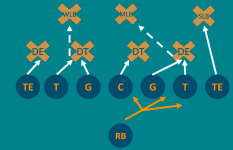original poster
New member
- Joined
- Nov 24, 2014
- Messages
- 3,201
- Reaction score
- 1

I thought I'd do a post about offensive line schemes as these always used to go down so well before and with Mike Solari on board, we will very likely see a change in scheme.
Zone Blocking Scheme, often referred to as ZBS
A zone blocking scheme is used by just about every team. Not exclusively, but most teams have the scheme at least incorporated into their playbook at some point.
The general idea of a ZBS is to simplify things. If you're a guard and you have a defensive tackle lined up in front of you who suddenly motions to the left or right just before the snap, what do you do? The ZBS removes that potential confusion by giving each lineman a specific area to block. It isn't always directly in front of them, either. In fact, it very rarely is directly in front of them.
The ZBS is very much designed around the run game and not the passing game, it is designed to not only create holes for running backs in the trenches, but to also get lineman downfield blocking linebackers and safeties at the second level. That's why you sometimes saw Seattle lineman sprinting downfield as soon as the ball is snapped, more often than not, the lineman responsible for the initial block failed their assignment which made the lineman on his way to the second level look a bit silly to the untrained eye, if the original blockers back at the line had done their job, it would very likely result in a chunk play for the RB.
Typically, the ZBS relies very heavily on double teams to create lanes.

In the example above. You can see the RG and RT's zone is to the right and straight ahead respectively, this means the defensive end will get double teamed. The centers zone is just to the right of him and is solely responsible for dealing with the defensive tackle.
As you can see, depending on how the play actually goes, the RB has 3 potential holes to choose. He's got the 2 gap between the center and the guard, the 4 gap between the guard and the tackle, or the 6 gap between the tackle and the tight end. Although before the play it looks like the 8 gap will be another option (between the tackle and tight end), as you can see the tight ends immediately heading to the second level to deal with the strong side linebacker so that gap won't be available once the ball is snapped.
Because the ball is running to the right, you don't need to 'over assign' for the weak side defensive end as he's on the opposite end of the line, however if the other defensive tackle is athletic, there's a chance he could try and break his block and go after the running back, so it's wise to assign the left tackle and left guard to block him and keep him where he is.
That's just one example, but you get the idea.
The reason you will often hear in scouting reports that an offensive lineman either has 'quick feet' or 'slow feet' or 'more of a north/south mover' is directly relating to his ability to play the ZBS.
Because ZBS lineman are doing a whole lot more moving, their agility, athleticism and footwork are far more important. 'technicians' is often a term used for lineman that are better suited to a ZBS. They don't need to be as strong or heavy (relatively speaking, of course) as they are very often double teaming someone and two 'technician' lineman will win match ups more often than not against all but the very best defensive ends and defensive tackles.
Communication is very much an important aspect of the ZBS, too. In each specific play, the lineman kind of choose their zone depending on what the defense is showing them. Communication was almost non existent on the Seahawks line last year, it's arguably the biggest reason for their failures.
If the line is communicating and knowing exactly what they're doing on that specific play, the play will almost certainly result in positive yardage. If just one of the lineman (especially on the playside rather than the backside, in the example above the playside is to the right, the backside is to the left) don't know what they're doing, there's a very strong chance the required holes will not be opened for the running back, thats when you see tackle's for losses and defensive lineman bursting through the trench untouched. I guarantee if the play was executed correctly, at least one lineman would have been responsible for the player bursting through the line, possibly even two offensive lineman.
Simply put, if you're not all on the same page, mistakes will happen and those mistakes will likely be costly.
If you had to categorize the ZBS, it would fall under 'finesse' and 'athleticism'.
What types of running backs fit a ZBS?
Speed isn't as important to a running back in a ZBS, it's all about their ability to see where the holes are being opened and getting there quickly.
Good footwork, ability to more laterally and acceleration are the most important. Once you get past that initial block, the play is a positive one and would be deemed successful. Of course, top speed may help once they're at the second level but the priority is to have the RB get past that initial block and you do that by identifying the hole quickly (vision) and getting to and through that hole (footwork and lateral movement).
Power Run Scheme
The basic principles of a PRS are to block a certain defensive player. They are all told to down block, meaning to block the gap away from the play side of the run. Their first rule is to block a man in their back-side gap, or work to the second level if they have no defender in their gap.
Typically the backside guys (the players lined up on the opposite side to where the running back will go going are expected to act as lead blockers in the second level (provided they can get there of course). The same applies to offensive lineman that don't have an assigned player, purely down to how the defense lines up.
The main difference with the power scheme is it creates a specific hole for the running back to burst through rather than giving him multiple options. It's probably more simple for the RB but can be complex for the lineman, especially the center as he often has multiple responsibilities and 'tasks' in the PBS.
If you have to categorize the PRS, it would fall into categories such as 'violent' and 'smash mouth'. Simply lining up, and beating up the guy opposite you. Obviously it is more complex than that, but you get the idea.
I'll be the first to admit that I don't have anywhere near as good a understanding of a power run scheme as I do the zone blocking scheme hence the lack of detail compared to the ZBS. I do however understand the basic principles and am currently learning the intricacies of the PRS so will come back to it at a later time once I can explain it in more detail.
What types of RB fit a PRS?
Because the gap is already predetermined, getting to that hole is the most important, so acceleration, top speed and strength are key. Acceleration to get to the hole quickly, top speed through the second level and strength to be able to deal with the defensive lineman that may be able to get a hand on their jersey to try and bring them down. If the play is successful, it's unlikely a defensive lineman will be in a position to actually tackle the RB, so his main concern once he's got through the first hole is linebackers and safeties (and occasionally cornerbacks). Good open field vision is handy as well as various moves such as stiff arms, jukes, etc.
It would be ridiculous to say that certain running backs can only thrive in one type of blocking scheme because that is rarely the case, however certain traits of said running back will certainly make him more successful in a given scheme.
What scheme will Seattle use under Mike Solari?
As we identified at the start of this article, most teams do use a combination of the two, however one is very often more favoured than the other. In Seattle's case, they ran a ZBS the vast majority of the time. When they did run a power scheme, it was very successful which is a bit of a head scratcher, but I guess that's one of the many reasons Tom Cable is no longer responsible for this group.
I obviously don't know for sure, however If I have to guess I'd say Seattle will predominantly run a power run scheme moving forwards, mixing in the ZBS to keep the defense on their toes.
John said himself in a recent interview that Fluker would not have fitted with their scheme last year however would fit this year. Again, indicating that it will mainly be the PBS given Fluker is certainly a mauler rather than a technician. The man is huge.
In terms of personnel, Ethan Pocic may very well find himself without a job next season if they go PRS. He is very much a technician whereas someone like D.J. Fluker and Germain Ifedi are more 'maulers' who would excel in the PRS. If Seattle finds a way to draft Will Hernandez he would be the ideal replacement at LG for a power run scheme and it would be hard to see how the run game wouldn't improve given the personnel, coaching change and scheme change but that's not really the point of this article and where the main point of discussion should be.
Also, if Solari does go heavy on the PRS, expect an investment at full back either via the draft or as an undrafted free agent. A good full back is essential to run a PRS. I wouldn't be at all surprised to see Dimitri Flowers drafted with one of Seattle's fifth round picks at the end of the month. Seattle has (or is) brining in fullback Khalid Hill into the VMAC for a pre draft visit. When you put all this info together, it shouts to me that Seattle will be going heavy with the power run as opposed to zone blocking.
Expect some mistakes in the early part of the season as it's quite the challenge for lineman to transition to a new scheme, but in the long run, I would say there's an incredibly strong chance the early struggles pay dividends in the not too distant future and Seattle can get back to the type of football that made them so great in recent years.

